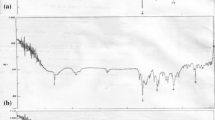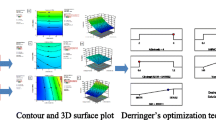Abstract
The aim of the present work was to study the main formulation variables that influence attributes of bioadhesive emulgels based on a combination of polymers, using response surface methodology (RSM). Bioadhesive products continue to gain attention in topical cutaneous administration as they allow long residence times on the application site, which is important when a long dermal action and a reduced product administration frequency are desired. A Box-Behnken design of experiments (DoE) was introduced to study the effect of formulation variables on quality attributes of the emulgels. The effects of concentration of carbomer interpolymer type A (Polym1), xanthan gum (Polym2) and mineral oil (Oil) on detachment force (Fdetch), spreadability (Spread), and phase separation by mechanical stress (PhSep) were investigated. RSM and desirability functions were applied for data analysis. Emulgels were further characterized by viscosity and extrudability measurements. Polym1 showed a positive effect on Fdetch, while the increase in concentrations of Polym2 and Oil decreased this property. Polym1 and Polym2 favored emulgel PhSep. However, their interaction effect decreased it. The combination of 0.4–0.6% of carbomer and 0.2–0.3% of gum was able to produce easy-to-spread bioadhesive emulgels with mineral oil as discontinuous phase in the presence of a low surfactant concentration. Based on the DoE results, value ranges for the variables, which could achieve for the experimental domain to get the critical quality attributes of emulgels jointly within the specification limits, were able to be identified using RSM supported by desirability functions.









Similar content being viewed by others
References
Al-Suwayeh SA, Taha EI, Al-Qahtani FM, Ahmed MO, Badran MM. Evaluation of skin permeation and analgesic activity effects of carbopol lornoxicam topical gels containing penetration enhancer. Sci World J. 2014; doi:10.1155/2014/127495.
Peppas NA, Bures P, Leobandung W, Ichikawa H. Hydrogels in pharmaceutical formulations. Eur J Pharm Biopharm. 2000;50:27–46.
Mohamed MI. Optimization of chlorphenesin emulgel formulation. AAPS J. 2004;6:81–7.
Bonacucina G, Cespi M, Palmieri GF. Characterization and stability of emulsion gels based on acrylamide/sodium acryloyldimethyl taurate copolymer. AAPS Pharm Sci Tech. 2009;10:368–75.
Allen LV, Popovich NG, Ansel HC, editors. Ansel’s pharmaceutical dosage forms and drug delivery systems. 9th ed. Philadelphia: Wolters Kluwer Health/Lippincott Williams & Wilkins; 2011.
Ajazuddin AA, Khichariya A, Gupta S, Patel RJ, Giri TK, Tripathi DK. Recent expansions in an emergent novel drug delivery technology: Emulgel. J Control Rel. 2013;171:122–32.
Tamburic S, Craig DQM. Rheological evaluation of polyacrylic acid hydrogels. J Pharm Sci. 1995;1:107–9.
Tamburic S, Craig DQM. An investigation into the rheological, dielectric and mucoadhesive properties of poly (acrylic acid). J Control Rel. 1995;37:59–68.
Blanco-Fuente R, Anguiamo-Igea S, Otero-Espinar FJ, Blanco-Méndez J. In-vitro bioadhesion of carbopol hydrogels. Int J Pharm. 1996;142:169–74.
Riley RG, Smart JD, Tsibouklis J, Dettmar PW, Hampson F, Davis JA, Kelly G, Wilber WR. An investigation of mucus/polymer rheological synergism using synthesised and characterised poly(acrylic acid)s. Int J Pharm. 2001;217:87–100.
Zatz JL, Kushla GP. Gels. In: Lieberman HA, Rieger MM, Banker GS, editors. Pharmaceutical dosage forms: disperse systems, vol. volume 2. 2nd ed. New York: Marcel Dekker, Inc.; 1996. p. 398–421.
Venkatraman S, Gale R. Skin adhesives and skin adhesion 1. Transdermal drug delivery systems. Biomaterials. 1998;19:1119–36.
Silva CL, Pereira JC, Ramalho A, Pais AACC, Sousa JJS. Films based on chitosan polyelectrolyte complexes for skin drug delivery: development and characterization. J Memb Sci. 2008;320:268–79.
Varma VNSK, Maheshwari PV, Navya M, Reddy SC, Shivakumar HG, Gowda DV. Calcipotriol delivery into the skin as emulgel for effective permeation. Saudi Pharm J. 2014;22:591–9.
Valenta C, Auner BG. The use of polymers for dermal and transdermal delivery. Eur J Pharm and Biopharm. 2004;58:279–89.
Osmałek T, Froelich A, Tasarek S. Application of gellan gum in pharmacy and medicine. Int J Pharm. 2014;466:328–40.
Zeng N, Dumortier G, Maury M, Mignet N, Boudy V. Influence of additives on a thermosensitive hydrogel for buccal delivery of salbutamol: Relation between micellization, gelation, mechanic and release properties. Int J Pharm. 2014;467:70–83.
Parente ME, Ochoa-Andrade A, Ares G, Russo F, Jimenez-Kairuz A. Bioadhesive hydrogels for cosmetic applications. Int J Cosm Sci. 2015;37:511–8.
GRAS Substances (SCOGS) database. U.S. food and drug administration. U.S. Department of Health and Human Services. http://www.accessdata.fda.gov/scripts/fdcc/?set=SCOGS. Accessed 28 Sept 2016.
Inactive Ingredients Database Download. U.S. Food and Drug Administration. U.S. Department of Health and Human Services. http://www.fda.gov/drugs/informationondrugs/ucm113978.htm. Accessed 28 Sept 2016.
Badawi MA, El-Khordagui LK. A quality by design approach to optimization of emulsions for electrospinning using factorial and D-optimal designs. Eur J Pharm Sci. 2014;58:44–54.
Armstrong NA, editor. Pharmaceutical experimental design and interpretation. 2nd ed. Boca Raton: CRC Press; 2006.
Myers RH, Montgomery DC, Anderson-Cook CM, editors. Response surface methodology: process and product optimization using designed experiments. 3rd ed. New Jersey: Wiley; 2009.
Gruber JV. Polysaccharide-based polymers in cosmetics. In: Goddard D, Gruber JV, editors. Principles of polymer science and technology in cosmetics and personal care. New York: Marcel Dekker, Inc.; 1999. p. 325–89.
R Development Core Team. R: a language and environment for statistical computing. Vienna: R Foundation for Statistical Computing, 2011. http://www.R-project.org/. Accessed 1 Dec 2011.
Lenth RV. Response-surface methods in R, using rsm. J Stat Softw. 2009;32:1–17.
Roth T. QualityTools: statistical methods for quality science. R package version 1.54; 2012. http://CRAN.Rproject. org/package = qualityTools. Accessed 1 Dec 2012.
Bachhav YG, Patravale VB. Microemulsion based vaginal gel of fluconazole: formulation, in vitro and in vivo evaluation. Int J Pharm. 2009;365:175–9.
Lubrizol. Measurement and understanding of yield value in home care formulations. Technical data sheet TDS-244. 2002. https://www.lubrizol.com/home-care/documents/technical-data-sheets/tds-244-measurement-understanding-yield-value-personal-care-formulations.pdf. Accessed 22 Jun 2016.
Chatterjee A, Bhowmik BB, Thakur YS. Formulation, in vitro and in vivo pharmacokinetics of anti-HIV vaginal bioadhesive gel. J Young Pharm. 2011;3:83–9.
Kuhn M. The desirability package. 2015. https://cran.r-project.org/web/packages/desirability/vignettes/desirability.pdf. Accessed 3 Mar 2016.
Bergum J., Pfahler L., Senderak E., Vukovinsky KE., Sethuraman S., Altan S. Statistical Considerations in design space development (part III of III). Pharm Technol. 2010;34. http://www.pharmtech.com/statistical-considerations-design-space-development-part-iii-iii. Accessed 3 May 2016.
Shahin M, Hady SA, Hammad M, Mortada N. Novel jojoba oil-based emulsion gel formulations for clotrimazole delivery. AAPS PharmSciTech. 2011;12:239–47. doi:10.1208/s12249-011-9583-4.
Estanqueiro M, Conceição J, Amaral MH, Santos D, Silva JB, Sousa Lobo JM. Characterization and stability studies of emulsion systems containing pumice. Braz J Pharm Sci. 2014;50:361–9. doi:10.1590/s1984-82502014000200016.
Schott H. Rheology. In: Gennaro AR, Chase GD, Marderosian AD, editors. Remington: The science and practice of pharmacy. 19th ed. Easton: Mack Publishing Company; 1995. p. 292–311.
Schramm LL. Emulsions, foams, and suspensions. Fundamental and applications. Weinheim: Wiley-VCH Verlag GmbH & Co. KGaA; 2005.
Miner PE. Emulsions rheology: creams and lotions. In: Laba D, editor. Rheological properties of cosmetics and toiletries. New York: Marcel Dekker Inc.; 1993. p. 313–70.
Laba D, editor. Rheological properties of cosmetics and toiletries. New York: Marcel Dekker Inc.; 1993.
Gruber JV. Synthetic polymers in cosmetics. In: Goddard D, Gruber JV, editors. Principles of polymer science and technology in cosmetics and personal care. New York: Marcel Dekker Inc.; 1999. p. 217–74.
Lubrizol. Carbopol®* Ultrez 10 polymer for personal care applications. Technical data sheet TDS-225. 2007. https://lubrizol.com/personal-care/documents/technical-data-sheets/tds-225-carbopol®-ultrez-10-polymer-for-personal-care-applications.pdf. Accessed 22 Jun 2016.
Lucero MJ, Vigo J, Leon MJ. A study of shear and compression deformations on hydrophilic gels of tretinoin. Int J Pharm. 1994;106:125–33.
Acknowledgements
The authors would like to thank Dr. Patricia Lema, Food Engineering, Facultad de Ingeniería, Universidad de la República, Montevideo, Uruguay.
Author information
Authors and Affiliations
Corresponding author
Rights and permissions
About this article
Cite this article
Ochoa-Andrade, A., Parente, M.E., Jimenez-Kairuz, Á. et al. Study of the Influence of Formulation Variables in Bioadhesive Emulgels Using Response Surface Methodology. AAPS PharmSciTech 18, 2269–2278 (2017). https://doi.org/10.1208/s12249-016-0707-8
Received:
Accepted:
Published:
Issue Date:
DOI: https://doi.org/10.1208/s12249-016-0707-8




